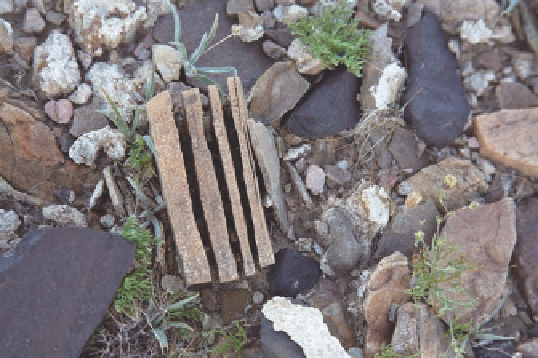Geoscience Reference
In-Depth Information
Figure 14.5 A rock sea.
This rock sea of boulders (or
felsenmeer
) in the Colorado Rockies was created through the
long-term process of frost action at high altitudes.
environments, large fields of fractured boulders form (Figure
14.5); they are called
felsenmeer
(German for “rock sea”).
In addition to its effects on rock, the freezing and thawing
of water can also cause modifications in soil. These modifica-
tions are most pronounced where soils are fine-textured with
horizontal planes between silt and clay particles. Under these
conditions, water collects in the planes and then expands up-
ward upon freezing, causing the soil to rise upward in a process
called
frost heaving
. If you happen to live in the northern part
of the United States or in Canada, you can often see evidence
of frost heaving in farm fields. In these areas, individual stones
and cobbles (large, rounded rock fragments) can be slowly
brought to the surface over time when water collects beneath
them and freezes. After each winter, farmers pull any freshly
surfaced rocks out of their fields to make plowing easier and
stack them in a pile at the edge of the lot. You can also see the
effects of frost heaving on northern paved roads when cracks
develop in them because they are uplifted somewhat during the
winter. Building contractors are acutely aware of the frost-heav-
ing process. To avoid problems with structures such as decks
settling in uneven ways, builders are required to install support
footings below the depth of the frost line. The depth of this line
is progressively greater with higher latitude or altitude.
Two other weathering processes have the same effect as
frost wedging in that they break down rocks into progressively
smaller fragments. One is related to the impact of plants when
their roots grow into cracks and joints in rock. As the plants
and associated roots grow, they can literally cause rock to split
farther apart (Figure 14.6) in a process called
root wedging
.
The second process takes place in association with temperature
changes that occur over the course of seasons, between day and
night, or due to changes in the direction in which the Sun faces
a rock over the course of the day. These temperature fluctua-
tions can cause rock to expand and contract when heated and
Figure 14.6 Plant roots and mechanical weathering.
Plants
can slowly break apart rocks when they grow in cracks such as
this one and enlarge over time.
cooled, respectively. Over the course of countless such cycles,
the rock will gradually break into progressively smaller pieces.
This kind of mechanical weathering is very common in arid
regions (Figure 14.7) or at high elevations where intense solar
radiation occurs during the day and radiational cooling prevails
at night.
Figure 14.7 Temperature changes and mechanical weathering.
This rock in the Mojave Desert has split into four pieces due to
thermal expansion and contraction.
Frost heaving
Upthrust of sediment or soil due to the freezing
of wet soil beneath.



